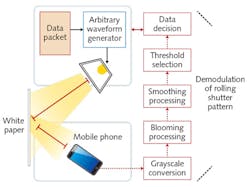Algorithms optimize nonline-of-sight optical wireless data sent to smartphones

Optical wireless communication (OWC) using one or more different-colored LEDs is being developed for communication between LEDs (serving as both lighting and an optical router) and devices such as laptops—data rates for these systems can reach into the gigahertz range. In fact, OWC is also possible between LED lighting and a smartphone, with the communication relying on the phone's CMOS camera as the data receiver. In this case, however, data communication is limited by the phone camera's video rates to painfully slow data rates of 150 bit/s (50 bit/s for each of red, blue, and green channels). The data rate can be boosted a bit to ~4.5 kbit/s by taking advantage of the rolling-shutter effect of the smartphone camera.
Researchers at National Chiao Tung University (Hsinchu, Taiwan), Philips Electronics (Hong Kong, China), and Feng Chia University, Seatwen (Taichung, Taiwan) have come up with data-detection algorithms for smartphones that can capture data at this 4.5 kbit/s rate, and do it in conditions of low-enough light that it can be used as a nonline-of-sight (NLOS) system—in other words, the smartphone does not need a clear line of sight to the LED bulb, but instead can capture data from the light bounced off a wall. Using a combination of background compensation (BC) blooming mitigation, extinction-ratio (ER) enhancement, and Bradley adaptive thresholding, the researchers transmitted error-free data over a test NLOS path of about 1.5 m. Reference: W.-C. Wang et al., Opt. Express (2017); https://doi.org/10.1364/oe.25.010103.
About the Author
John Wallace
Senior Technical Editor (1998-2022)
John Wallace was with Laser Focus World for nearly 25 years, retiring in late June 2022. He obtained a bachelor's degree in mechanical engineering and physics at Rutgers University and a master's in optical engineering at the University of Rochester. Before becoming an editor, John worked as an engineer at RCA, Exxon, Eastman Kodak, and GCA Corporation.
